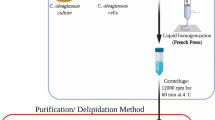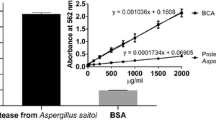Abstract
In this study, we compared different total protein extraction protocols to achieve highly efficient isolation and purification of total proteins for the specific protein profiling of Oenococcus oeni. The sodium dodecyl sulfate-polyacrylamide gel electrophoresis patterns obtained for the different extraction protocols revealed not only a qualitative similar protein pattern but also quantitative variations with different intensity bands depending on the extraction method used. The selected extraction method added with sonication proved to work extremely well and efficiently and was able to obtain a high-resolution 2-D electrophoresis (2-DE) map. Prominent spots were successfully identified by matrix-assisted laser desorption-ionization time-of-flight mass spectrometry and corresponded to 76 different proteins involved in the main metabolic pathways. The approach allowed to achieve a protein profiling specific for O. oeni from Aglianico wine with numerous characterized protein products corresponding to many different O. oeni genes and associated with main cellular pathways. Further investigations of the 2-DE protein expression profile will provide useful and interesting information on the molecular mechanisms at the protein level responsible for growth and survival of O. oeni in wine.



Similar content being viewed by others
References
Arena S, D’Ambrosio C, Renzone G, Rullo R, Ledda L, Vitale F, Maglione G, Varcamonti M, Ferrara L, Scaloni A (2006) A study of Streptococcus thermophilus proteome by integrated analytical procedures and differential expression investigations. Proteomics 6:181–192
Barbagallo RN, Spagna G, Palmeri R, Torriani S (2004) Assessment of β-glucosidase activity in selected wild strains of Oenococcus oeni for malolactic fermentation. Enzym Microb Technol 34:292–296
Bartowsky EJ, Borneman AR (2011) Genomic variations of Oenococcus oeni strains and the potential to impact on malolactic fermentation and aroma compounds in wine. Appl Microbiol Biotechnol 92:441–447
Bon E, Delaherche A, Bilhére E, De Daruvar A, Lonvaud-Funel A, Le Marrec C (2009) Oenococcus oeni genome plasticity is associated with fitness. Appl Environ Microbiol 75:2079–2090
Bonomo MG, Ricciardi A, Salzano G (2011) Influence of autochthonous starter cultures on microbial dynamics and chemical-physical features of traditional fermented sausages of Basilicata region. World J Microbiol Biotechnol 27:137–146
Bourdineaud JP, Nehmé B, Tesse S, Lonvaud-Funel A (2003) The ftsH gene of the wine bacteria Oenococcus oeni is involved in protecting against environmental stress. Appl Environ Microbiol 69:2512–2520
Bradford M (1976) A rapid and sensitive method for the quantitation of microgram quantities of protein utilizing the principle of protein-dye binding. Anal Biochem 72:248–254
Canas PMI, Perez PR, Prieto SS, Herreros MLP (2009) Ecological study of lactic acid microbiota isolated from Tempranillo wines of Castilla-La Mancha. J Biosci Bioeng 108:220–224
Capozzi V, Russo P, Beneduce L, Weidmann S, Grieco F, Guzzo J, Spano G (2010) Technological properties of Oenococcus oeni strain isolated from typical southern Italian wines. Lett Appl Microbiol 50:327–334
Cecconi D, Milli A, Rinalducci S, Zolla L, Zapparoli G (2009) Proteomic analysis of Oenococcus oeni freeze-dried culture to assess the importance of cell acclimation to conduct malolactic fermentation in wine. Electrophoresis 30:2988–2995
Cho MJ, Jeon BS, Park JW, Jung TS, Song JY, Lee WK (2002) Identifying the major proteome components of Helicobacter pylori strain 26695. Electrophoresis 23:1161–1173
Coucheney F, Desroche N, Bou M, Tourdot-Maréchal R, Dulau L, Guzzo J (2005) A new approach for selection of Oenococcus oeni strains in order to produce malolactic starters. Int J Food Microbiol 105:463–470
de Las Rivas B, Marcobal A, Munoz R (2004) Allelic diversity and population structure in Oenococcus oeni as determined from sequence analysis of housekeeping genes. Appl Environ Microbiol 70:7210–7219
Delaherche A, Bon E, Dupe A, Lucas M, Arveiler B, De Daruvar A, Lonvaud-Funel A (2006) Intraspecific diversity of Oenococcus oeni strains determined by sequence analysis of target genes. Appl Microbiol Biotechnol 73:394–403
Gomez-Alegrìa E, Lopez I, Ignacio Ruiz J, Saenz J, Fernandez E, Zarazoga M, Dizy M, Torres C, Ruiz-Larrea F (2004) High tolerance of wild Lactobacillus plantarum and Oenococcus oeni strains to lyophilisation and stress environmental conditions of acid pH and ethanol. FEMS Microbiol Lett 230:53–61
Gonzalez-Arenzana L, Lopez R, Santamaria P, Tenorio C, Lopez-Alfaro I (2012) Dynamics of indigenous lactic acid bacteria populations in wine fermentations from la Rioja (Spain) during three vintages. Microb Ecol 63(1):12–19. doi:10.1007/s00248-011-9911-y
Gorg A, Weiss W, Dunn MJ (2004) Current two-dimensional electrophoresis technology for proteomics. Proteomics 4:3665–3685
Izquierdo PM, Ruiz P, Seseña S, Palop ML (2009) Ecological study of lactic acid microbiota isolated from Tempranillo wines of Castilla–La Mancha. J Biosci Bioeng 108:220–224
Laemmli UK (1970) Cleavage of structural proteins during the assembly of the head of bacteriophage T4. Nature 227:680–685
Lechiancole T, Blaiotta G, Messina D, Fusco V, Villani F, Salzano G (2006) Evaluation of intra-specific diversities in Oenococcus oeni through analysis of genomic and expressed DNA. Syst Appl Microbiol 29:375–381
Lehner I, Niehof M, Borlak J (2003) An optimized method for the isolation and identification of membrane proteins. Electrophoresis 24:1795–1808
Marcobal AM, Sela DA, Wolf YI, Makarova KS, Mills DA (2008) Role of hypermutability in the evolution of the genus Oenococcus. J Bacteriol 190:564–570
Michlmayr H, Schümann C, Wurbs P, Barreira Braz da Silva NM, Rogl V, Kulbe KD, del Hierro AM (2010) A β-glucosidase from Oenococcus oeni ATCC BAA-1163 with potential for aroma release in wine: cloning and expression in E. coli. World J Microbiol Biotechnol 26(7):1281–1289
Mills DA, Rawsthorne H, Parker C, Tamir D, Makarova K (2005) Genomic analysis of Oenococcus oeni PSU-1 and its relevance to winemaking. FEMS Microbiol Rev 29:465–475
Prunier AL, Leclercq R (2005) Role of mutS and mutL genes in hypermutability and recombination in Staphylococcus aureus. J Bacteriol 187:3455–3464
Reguant C, Carreté R, Constantí M, Bordons A (2005) Population dynamics of Oenococcus oeni strains in a new winery and the effect of SO2 and yeast strain. FEMS Microbiol Lett 246:111–117
Renouf V, Delaherche A, Claisse O, Lonvaud-Funel A (2008) Correlation between indigenous Oenococcus oeni strain resistance and the presence of genetic markers. J Ind Microbiol Biotechnol 35:27–33
Ruiz P, Izquierdo PM, Sesena S, Palop ML (2008) Intraspecific genetic diversity of lactic acid bacteria from malolactic fermentation of Cencibel wines as derived from combined analysis of RAPD-PCR and PFGE patterns. Food Microbiol 25:942–948
Ruiz P, Izquierdo PM, Sesena S, Palop ML (2010) Selection of autochthonous Oenococcus oeni strains according to their oenological properties and vinification results. Int J Food Microbiol 137:230–235
Sato H, Yanagida F, Shinohara T, Suzuki M, Suzuki K, Yokotsuka K (2001) Intraspecific diversity of Oenococcus oeni isolated during red wine-making in Japan. FEMS Microbiol Lett 202:109–114
Sico MA, Bonomo MG, Salzano G (2008) Isolation and characterization of Oenococcus oeni from Aglianico wines. World J Microbiol Biotechnol 24:1829–1835
Sico MA, Bonomo MG, D’Adamo A, Bochicchio S, Salzano G (2009) Fingerprinting analysis of Oenococcus oeni strains under stress conditions. FEMS Microbiol Lett 296:11–17
Silveira MG, Baumgartner M, Rombouts FM, Abee T (2004) Effect of adaptation to ethanol on cytoplasmic and membrane protein profiles of Oenococcus oeni. Appl Environ Microbiol 70:2748–2755
Solieri L, Genova F, De Paola M, Giudici P (2010) Characterization and technological properties of Oenococcus oeni strains from wine spontaneous malolactic fermentations: a framework for selection of new starter cultures. J Appl Microbiol 108:285–298
Sumby KM, Matthews AH, Grbin PR, Jiranek V (2009) Cloning and characterization of an intracellular esterase from the wine-associated lactic acid bacterium Oenococcus oeni. Appl Environ Microbiol 75:6729–6735
Vallet A, Santarelli X, Lonvaud-Funel A, de Revel G, Cabanne C (2009) Purification of an alcohol dehydrogenase involved in the conversion of methional to methionol in Oenococcus oeni IOEB 8406. Appl Microbiol Biotechnol 82:87–94
Vigentini I, Picozzi C, Tirelli A, Giugni A, Foschino R (2009) Survey on indigenous Oenococcus oeni strains isolated from red wines of Valtellina, a cold climate wine-growing Italian area. Int J Food Microbiol 136:123–128
Wessel D, Flügge UI (1984) A method for the quantitative recovery of protein in dilute solution in the presence of detergents and lipids. Anal Biochem 138:141–143
Wydau S, Dervyn R, Anba J, Dusko Ehrlich S, Maguin E (2006) Conservation of key elements of natural competence in Lactococcus lactis ssp. FEMS Microbiol Lett 257:32–42
Yanagida F, Srionnual S, Chen YS (2008) Isolation and characteristics of lactic acid bacteria from koshu vineyards in Japan. Lett Appl Microbiol 47(2):134–139
Zapparoli G, Reguant C, Bordons A, Torriani S, Dellaglio F (2000) Genomic DNA fingerprinting of Oenococcus oeni strains by pulsed-field gel electrophoresis and randomly amplified polymorphic DNA-PCR. Curr Microbiol 40:351–355
Ze-Ze L, Tenreiro R, Paveia H (2000) The Oenococcus oeni genome: physical and genetic mapping of strain GM and comparison with the genome of a “divergent” strain, PSU-1. Microbiology 146:3195–3204
Author information
Authors and Affiliations
Corresponding author
Rights and permissions
About this article
Cite this article
Cafaro, C., Bonomo, M.G., Rossano, R. et al. Efficient recovery of whole cell proteins in Oenococcus oeni—a comparison of different extraction protocols for high-throughput malolactic starter applications. Folia Microbiol 59, 399–408 (2014). https://doi.org/10.1007/s12223-014-0312-8
Received:
Accepted:
Published:
Issue Date:
DOI: https://doi.org/10.1007/s12223-014-0312-8




